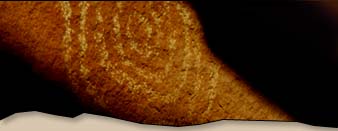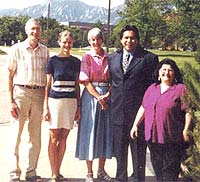
Sun-Earth Day Presents: Ancient Observatories, Timeless Knowledge

Culture and Connections in Science
By Barbara Sorensen, "Winds of Change" Autumn 2001
A SOARS Protege Shares His Experiences
"Indigenous people were aware of their environment. You can see it in their pottery, in their art that reflects geometric designs and patterns. This observation of our natural world is part our culture. Knowing your environment is part of science and this was a necessary part of our survival."
Michael Ray Johnson, who is part Laguna Pueblo, part Navajo and part Acoma, sits across from me in the Foothills Lab in building in Boulder, Colorado sipping coffee. He is relaxed and reflective after just completing a presentation entitled, "Ground-based Magnetometer Data for the Study of Electric Currents in the Ionosphere over the Polar Region." The colloquium was attended by fellow Significant Opportunities in Atmospheric Research and Science (SOARS) program participants, mentors, SOARS Director Tom Windham, friends, and an assortment of scientists. The summer program that Johnson is a part of was formed to increase minority representation in the science community. As successful as SOARS is, Johnson is not here to talk to me specifically about the program. His intent is to have me understand how science has always been interwoven throughout Native culture, and the opportunities it offers indigenous people.
Michael Johnson moved around the United States as a child because his father was in the Navy. When Michael was 12, his father, who had served for 20 years, had the option to retire or to continue on for another ten years. He asked his family what he should do and where they wanted to live. It was a unanimous decision; they all wanted him to retire and bring the family back to Laguna Reservation. They missed the connection, the thread of family and traditional stories that had kept them whole throughout their travels. "Every time I go back home," explains Johnson, "even now I want to soak up learning from the Elders and my tribe. I will forever be the dry sponge in order to soak up knowledge. I had an uncle who just died who knew so many traditional stories and ways of thinking that were very mathematical and scientific. He would tell us about the way the sun shone, the angles of light and how it would effect the different traditional ceremonies. I learned how the environment affects us and how to stand outside myself, to stand back and observe. I acquired a hunger to know more and found myself wondering about the smaller worlds and how they fit into everything."
Johnson earned an associate's degree in electronic technology from Southwestern Indian Polytechnic Institute (SIPI) in Albuquerque, New Mexico. After working for a year at Intel as a semi-conductor manufacturing technician, Johnson decided that he needed more education. He enrolled at New Mexico Tech (NMT) in Socorro where he is working towards a bachelor's degree in computer science. Being involved with the SOARS summer program has also familiarized Johnson with graduate school, and has given him insight into how to pursue a master's degree. "If I go to grad school," he says, "I would like to study federal Indian law and a science."
At SOARS, his background in computer science helps Johnson immensely. "Though only two of us were computer science majors," Johnson emphasizes, "many of the other majors knew a lot about computers and high-level computer programming languages. Everyone had some type of programming and/or computer science courses applicable to their majors. There are a lot of community colleges starting associate programs in network management of computer systems. NMT is just starting a program this fall which is sponsored by Microsoft. Wireless communication is a big topic and I think we'll see that grow rapidly."
Reawakening Knowledge
To Johnson, exploring the world of science brings young Native people back to their traditional heritage. "In the old cultures there were many indications that the people had the understanding of math and science." He says. "My uncle would tell us stories about how the tribes settled in certain spots based on scientific observations. Indigenous people were aware of their environment. You can see it in their pottery, in their art that reflects geometric designs and patterns. This observation of our natural world is part of our culture. Knowing your environment is part of science and this was a necessary part of our survival. Now, people are so caught up in technological pleasures that they stop looking up and around. They're not concerned with how the outside world affects their own personal world. When something in the environment happens, they look for an explanation but they don't know what to do about it."
During his presentation on electric currents in the ionosphere over the polar region, Johnson carefully threaded his indigenous understanding of observation into his talk. "When I was a child, I learned to notice the connection between the sun and the earth. As children, Native people are taught to pay attention to the environment and how it affects our family and community." Johnson also spent a lot of time explaining the uses of analyzing magnetometer data. He understood that the actual applications of research go a long way in drawing the interest of young people to science. "When we have large storms with magnetic intensity," he explained, "they can affect satellites which may go out of orbit, navigation systems, communication systems, astronaut safety, and electric power. Magnetometer data can also help in the prediction of electric storms." The connections between the abstracts of science and their everyday applications are what Johnson hopes will entice more young people to science.
Preparation and Mentors
"Being at SOARS," Johnson explains, "has been wonderful because I'm here with all these other scientists, reading their papers, going to their talks, and they've including me in their groups. I can walk into their office and ask them for help on a concept, a graph, or what direction my research can go." He urges students to look for programs like SOARS that "give underrepresented people a taste of science in its actual environment-where it's actually happening. Programs like SOARS set you up with mentors who encourage you and give you feedback on how you learn. I have science research mentors, a scientific writing mentor, a community mentor and a peer mentor. These mentors helped me realize that I learn holistically in contrast to a reductionist way of viewing the world. I always knew that I wanted to express myself in a broader, fuller way. I observed how everything comes together, how there in communication and interaction between everything in the universe. This program just reawakened me to how I need to proceed with my learning."
It is this realization of the interconnectedness of every element of earth that will continue to keep Johnson fascinated. "There are so many studies that are brand new and open," he enthuses. "If young Native people want to find out more about their environment, either at the microscopic or macroscopic level, I tell them 'Get into science! It will open your eyes to how the environment simultaneously affects us."
